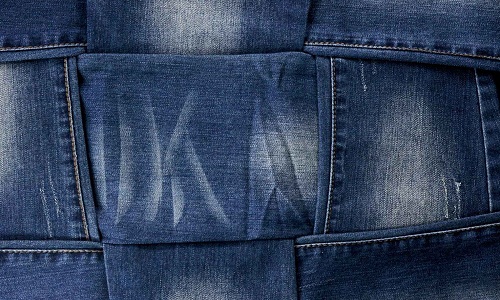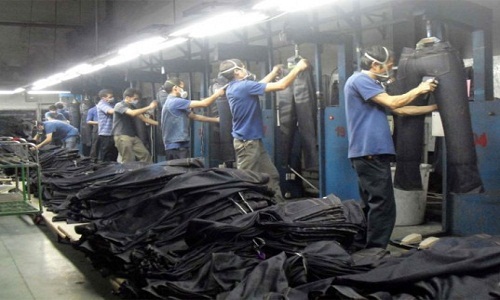FW
Saying that Tirupur does not have proper amenities for medical treatment, exporters want an ESI hospital with the necessary facilities to cater to patients with various major health problems. They want funds to build women’s hostels and labor quarters.
More than five lakh workers, mainly women, are employed in the sector directly and indirectly. About 65 per cent of the 3.5 lakh workers are women from a rural background. About 44 per cent of its 8.78 lakh population is employed in the knitwear and stakeholder units. Exporters also want a Rs 200 crores central grant to set up effluent plants.
The Tirupur knitwear trade contributes a revenue of Rs 33,000 crores a year, both from exports and the domestic market. Now, it wants comparative advantages its counterpart cities have, mainly in infrastructure and other business facilities like the smart city tag. Tirupur has been included in the list of smart cities but nothing further has been done. The city wants further action on this front and some movement in that direction as that would directly help increase exports from that town and upgrade the quality of life.
Among 506 cities and towns of India that provide employment, Tirupur occupies a premier position.
Teijin has developed a new aramid fiber fabric suited for use in high-visibility protective apparel thanks to its extra-vivid coloring and resistance to fading. The new aramid fabric is expected to meet growing demands for safety clothing that offers comfort and maneuverability as well as high visibility.
The new aramid fabric is fully compliant with international standards for high-visibility clothing that enables others to see the wearer in a variety of lighting conditions. Over the decades, Teijin’s durable, heat-resistant, flame-retardant aramid fibers have contributed to the advancement of safety and protective apparel, providing police, firefighters and chemical-plant workers with high-performance clothing favored for their high-visibility, flame-retardant and flame-proof properties.
Teijin is strengthening its leading position in the Japanese market for protective apparel, putting forward new hybrid safety solutions that combine various high-performance materials to meet diverse customer demands.
Teijin is a global group operating in the fields of advanced fibers and composites, electric materials and performance polymer products, nylon, acetate, aramid, and polyvinyl chloride for apparel and industrial materials, healthcare and fiber. Teijin also makes polyester films used in advanced magnetic media and electronics equipment, pharmaceuticals, medical products, and information systems equipment.
The company’s global development initiatives are expected to boost sales in the global market for safety and protection.
A state-of-the-art textile processing and power loom weaving cluster is coming up in Gujarat, near Surat. It’s planned on 50 lakh sq. mt. of coastal land. However, allotment is awaited. The cluster is for those who want to produce fabric in bulk quantities. Barring a few big process houses and weaving units, most factories produce fabric in smaller volumes. But importers prefer suppliers who produce goods in bulk quantity.
The textile processing units will be connected with a common boiler system thereby discouraging the use of chimneys emitting pollution. There will be wind power and solar power generation, common drainage, CETP plant, tertiary treatment plant etc.
The plan is to have only processing and weaving at the cluster, and also garment units. So investors from Trichy, the garmenting hub, who are looking for expansion will be invited to explore prospects and opportunities.
If everything goes well, textile processing and power loom weaving units in Surat would be induced to shift to the planned cluster. The project has been planned by the Southern Gujarat Chamber of Commerce and Industry and the South Gujarat Textile Processors' Association.
Meanwhile, around 50 textile processing houses in China are willing to set up units in Surat. A delegation will soon visit China to explore possibilities.
The textile industry says it’s entitled to dues worth Rs 3,000 crores under the Technology Upgradation Fund Scheme. But it is unlikely these dues will be released. That means, liabilities related to the blackout or left out period cases will be given a silent burial.
The blackout period (June 20, 2010 to April 27, 2011) refers to a time when subsidy payments under the Technology Upgradation Fund Scheme were halted temporarily. The aim was to change the contours of the scheme from an open-ended scheme to a closed-ended one. The revised scheme came in April 2011.
Those who had invested during those 10 months of the blackout period, and were awaiting a decision on the eligibility of TUFS on the blackout period, have now got their answer. They are disappointed the funds are not going to be released. And the reason given is that there is a paucity of funds.
These textile units say they have continuously been under severe stress since April 2014 due to the non disbursal of committed liabilities under the TUFS scheme. Several hundreds of spinning mills are facing closure as they are likely to become non-performing assets.
So the textile industry has made a representation that the committed liabilities under TUFS scheme be disbursed and that cotton yarn be extended export benefits like Merchandise Exports from India Scheme on par with other textile products.
Pakistans’s garment, textile machinery and accessories exhibition Igatex will be held next April. The event is known to not only introduce the newest expertise but also improvise trade benefits and increase foreign investments and spending through business visits by international delegates.
As the largest textile and garment machinery show in Pakistan, it gathers more than 550 exhibitors from around 35 countries including Austria, Belgium, Canada, China, France, Germany, Greece, Holland, India, Italy, Japan, Korea, Portugal, Spain, Sweden, Singapore, Switzerland, Taiwan, Turkey, UK, USA etc with a number of innovative and versatile machinery models to be debuted at the fair.
Igatex Pakistan has played a pivotal role in the development of the textile industry by introducing efficient machinery to local manufacturers. It is becoming an increasingly significant textile and garment event with its scale setting new records year by year.
The event showcases products from apparel and clothing, plant, machinery and equipment, textiles, fabrics and yarns, business services, automation systems, embroidery and circular knitting machines, bleaching and washing machines, knitting and stitching industries.
Attendees are industry experts, scientists and executives of the fur, fabrics, clothing, textiles and fashion areas. This includes CEOs, distributors, importers, technical managers.
India’s exports of cotton-based readymade goods dropped by two per cent in 2015-16, while exports of cotton fabrics declined a little more than four per cent. The high price of domestic cotton, coupled with heavy duties on import of cheaper Chinese varieties, have hampered production of cotton goods.
This was part of a larger trend of a fall in merchandise exports, down for a seventeenth continuous month in April. Apart from cotton, manmade yarn also registered a major decline in export, of 11 per cent.
High export demand has pushed up prices. Also, high dependence on exports to China and the sensitivity of India's shipments to China's policy on a reserve cotton stock are a factor for the fall in cotton-based exports. India is likely to produce 34.1 million bales in the 2015-16 season, which ends on September 30. This is down from last year's 38.3 million bales. Successive droughts have reduced the supply from India, traditionally world leader in cotton production.
Textile exports are 13 per cent of all exports in terms of revenue earned. But a fall in FY ’16 is expected. This is because the rate of growth was a marginal 0.5 per cent in 2014-15, down from a significant rise of 12.4 per cent the year before.
"Industry leaders behind Rational Denim are hoping their collaborative project around responsibly produced denim will help pave the path for others to follow. Major players like Archroma, Garmon, Lenzing and Royo, each an expert in its respective area of supply chain, share the same belief that denim garments can be made in a more responsible way. And that’s exactly what the four set out to prove when they decided to team up."

Industry leaders behind Rational Denim are hoping their collaborative project around responsibly produced denim will help pave the path for others to follow. Major players like Archroma, Garmon, Lenzing and Royo, each an expert in its respective area of supply chain, share the same belief that denim garments can be made in a more responsible way. And that’s exactly what the four set out to prove when they decided to team up.
Sharing innovations

The ‘Roadmap to Rational Denim,’ to give the project its full title, debuted at Kingpins in Amsterdam recently, showcasing a prototype collection produced with the most efficient use of resources - particularly water - from fiber to finish. According to Alberto De Conti, Chief Marketing Officer at Garmon, they were drawn to the idea of being part of a group of companies that’s truly science-driven; a pool of industrial realities bringing to the table results that are rooted in sound research and development. Rational Denim takes a respectful distance from a number of so-called ‘sustainable’ market initiatives that are superficial, if not artificial. It is about delivering a pragmatic, highly responsible, very credible approach to denim product innovation and making it available to the creative minds throughout the world. As per Archroma’s estimates, nearly two trillion liters of water are consumed monthly in the production of 167 million pairs of jeans.
Each company contributed its expertise in a particular part of the denim manufacturing pipeline, to that end: Lenzing brought its class-leading fiber Tencel to the table; Archroma offered its Advanced Denim dyeing technology for indigo alternatives; Royo, with its years of experience using Tencel, produced the fabrics, both 100 per cent Tencel and cotton blends; and Garmon’s Green Screen-approved products simplified the finishing process.
An exhibition space was set up so that designers in search of inspiration could discuss their projects and ideas with representatives from the participating companies at Kingpins.
Flexibility and scope

The impression the denim players received was that a denim article produced in a fully sustainable way, cotton to final garment, and would not be attractive enough, with a totally different look to what is considered conventional denim. The stakeholders wanted to prove that this perception did not have a rational and that it was actually the other way round points out Miguel Sanchez, Head of Archroma. Not only could Rational Denim offer the same type of looks expected in conventional denim, but it could also widen the scope of colors, effects and final looks that are expected in a continuously evolving article like jeans.
Sanchez added that the most important aspect of the project is that the Rational Denim concept allows this flexibility, all within a production model where water and other resources are saved in each single step along the line. Andrew Olah, Founder and organizer of Kingpins, adds the project showed that sustainability is not a boundary. It is a source of inspiration and desire for fashion with soul and care.
Nevertheless, something is still holding denim mills back from integrating more sustainable practices, while a technology such as Archroma’s Advanced Denim is said to cut water consumption by 92 per cent, as well as energy usage by 30 per cent and waste by 87 per cent.
Suggested De Conti that fabric mills find themselves squeezed between the marginal, premium price they have to pay for responsible innovation in fibers, dyes and chemicals, and the reluctance shown by some of their brand and retail customers to take part of that burden onboard. As the Rational Denim tagline puts it, creativity without sustainability no longer makes sense.
Sanchez opined that brands are the connection between two dimensions - the end consumer and production - and brands should play an active role in informing end consumers about what it takes to make the jeans and the implications for the environment, so that everything isn’t about look and price.
Aiming for an over 21 per cent rise in outbound shipments from the actual level of 2015-16, the government of India has fixed textile and clothing export target at $48.5 billion for the current fiscal, textile Minister Santosh Kumar Gangwar said. The country’s overall textile and garment exports remained almost flat at $40 billion in the last fiscal, said a senior textile ministry official. Still, the exports fell short of the official target of $45-47.5 billion for 2015-16.
With demand from China remaining tepid and recovery in the developed markets like the US and the EU still fragile, the ambitious shipment target for the current fiscal would be hard to achieve, especially in view of stiff competition from countries like Vietnam, Bangladesh and Pakistan.
According to official sources, for its part, the textile ministry has sought a quick resolution of the India-EU free trade agreement, which would pave the way for duty-free access of Indian textile and garment items to the EU, which account for over a third of the country’s garment exports.
Gangwar said the ministry has spent over Rs 6,500 crores on various schemes for the promotion and development of the textile sector. Roughly 5 lakh additional jobs have been created in the past two years in the textiles sector, he added.
Commemorating its 20th anniversary, EURATEX hosted its international conference, ‘Best in Partnerships’ devoted to inter-sectorial partnerships to boost European manufacturing recently. The European Commissioner for Internal Market, Industry, Entrepreneurship and SMEs, Elżbieta Bieńkowska delivered the keynote addressed and said that textile and fashion industry is a strategic sector in the EU and it is really performing well. The European Commission is undertaking a number of actions to meet three main challenges of the sector: innovation, international competition and skills shortage.
In his address, EURATEX’s president Serge Piolat emphasised that textile and fashion sector is appreciating the European Commission’s willingness to build a dialogue with the industry. EURATEX proposed a concrete action plan to the European Commission to strengthen internationalisation of the SMEs, assure fair conditions for the European companies through stricter market surveillance, provide better access for SMEs to EU research funds and boost innovation investments at regional level through RegioTex initiative. ‘We are strongly committed to show meaningful results and we have equally high expectations of concrete actions from the policy-makers’, said Piolat.
The textile and fashion industry invited other sectors to identify common challenges and discuss new areas of cooperation. The conference was organised in a new format of Industrial Dialogues when two at a time representatives of different sectors had a free discussion between them and with the audience. The topics addressed were circular economy, creative industries, education and skills and international trade.
According to the 2016 Technical Textiles Top Markets Report brought out by the US Department of Commerce’s International Trade Administration, advances in medical technology, rising incomes and higher standards of living, increased spending on healthcare and an expanding construction sector are some of the key drivers fuelling growing demand for US technical textiles.
The report looks at the state of play for US exports of technical textiles. It forecasts an increase in trade of 4 per cent annually through 2017, and cites innovation, new technology and trade relationships developed under existing and future free-trade agreements as sustaining the projected growth.
It also highlights nine key countries offering particular opportunities for growth in the US technical textiles field – Brazil, Canada, China, India, Korea, Mexico, Singapore, Taiwan and Vietnam. Mexico and Canada are the two biggest markets for US exports, accounting for 55 per cent of total trade, and according to the report a boom in Mexico’s car manufacturing industry has had a direct effect on demand for industrial fabrics. The report advises the US to maintain awareness of the value of the North American market, adding that the future of the industrial textile industry will largely depend on new technology, and how it is applied.












